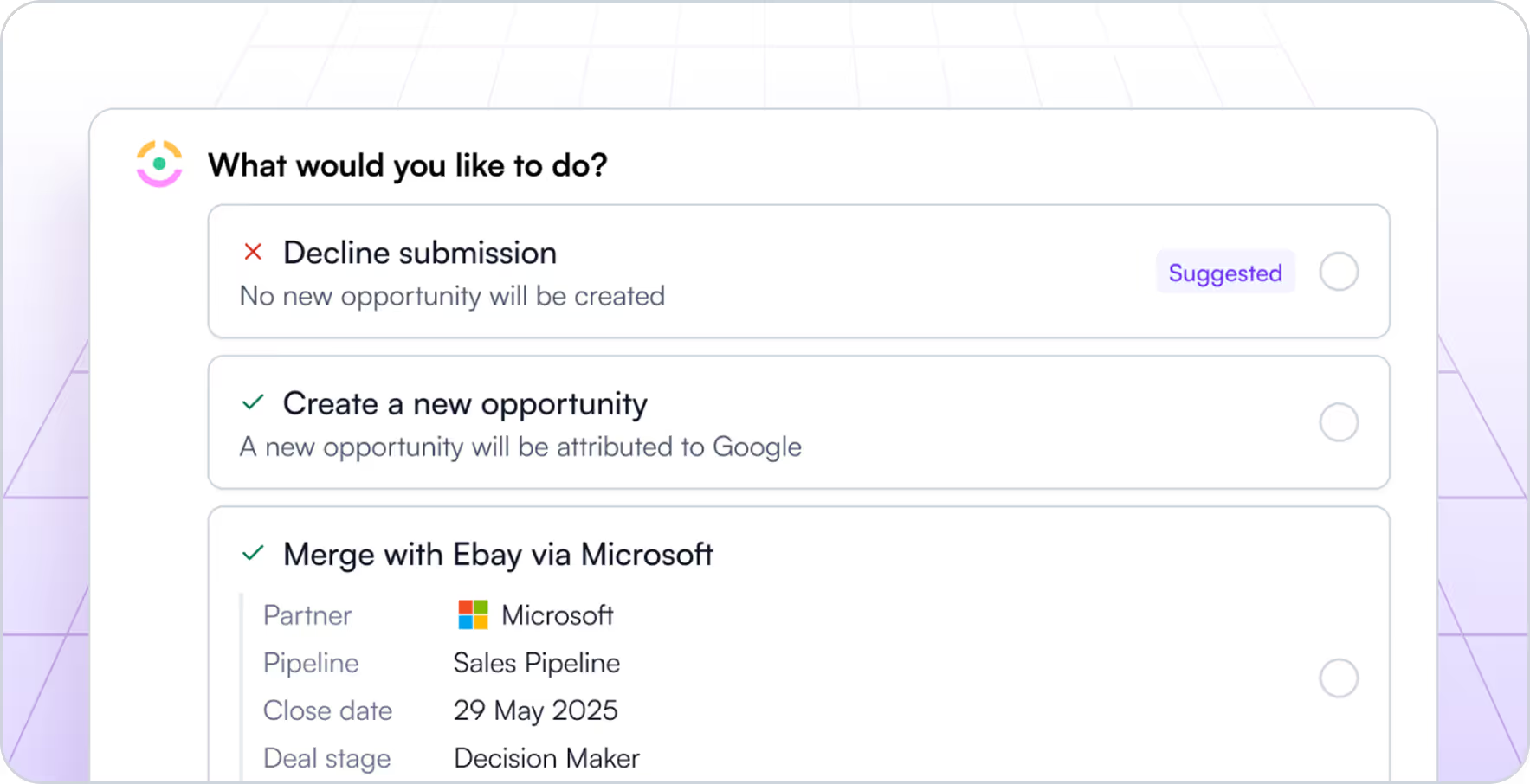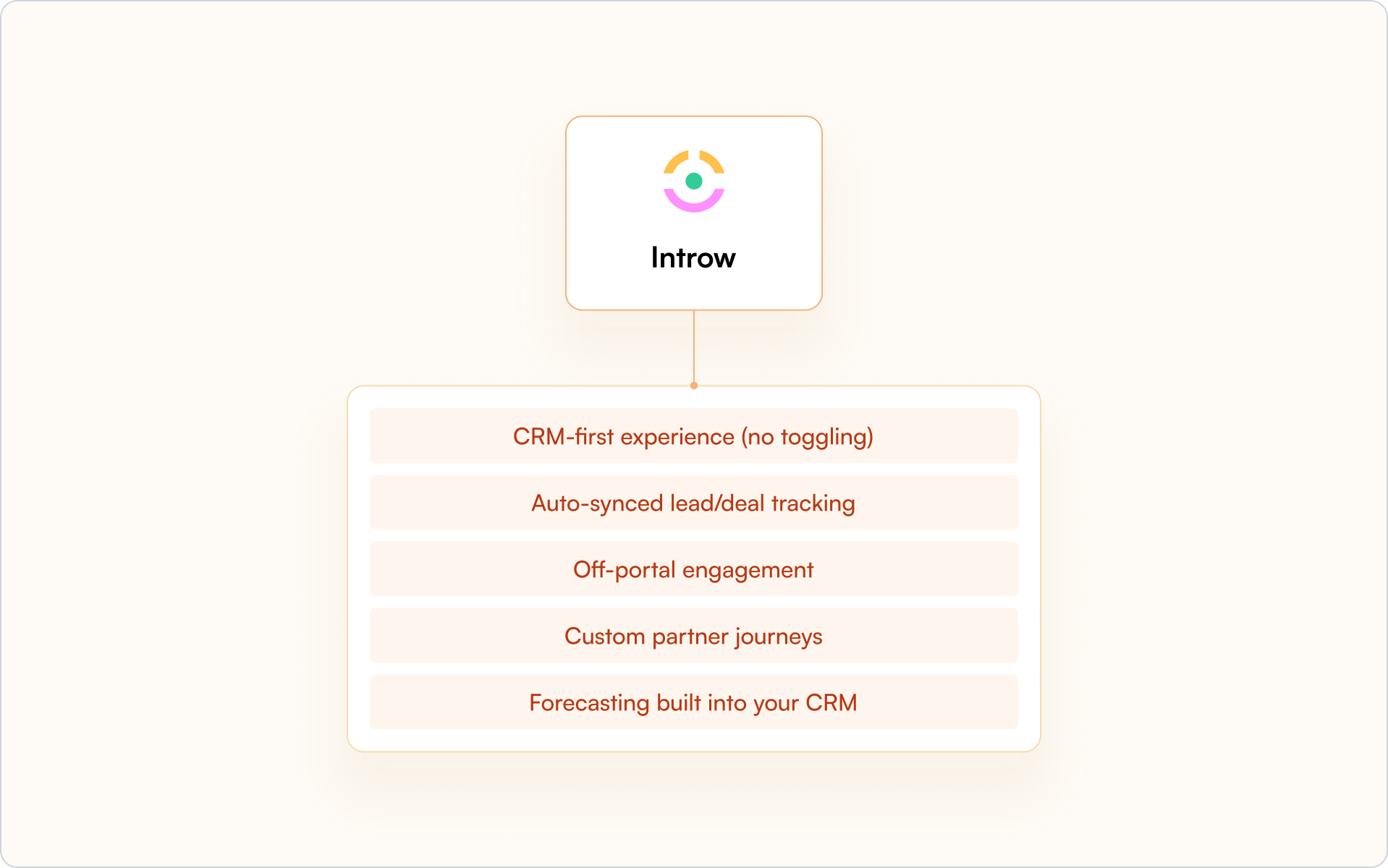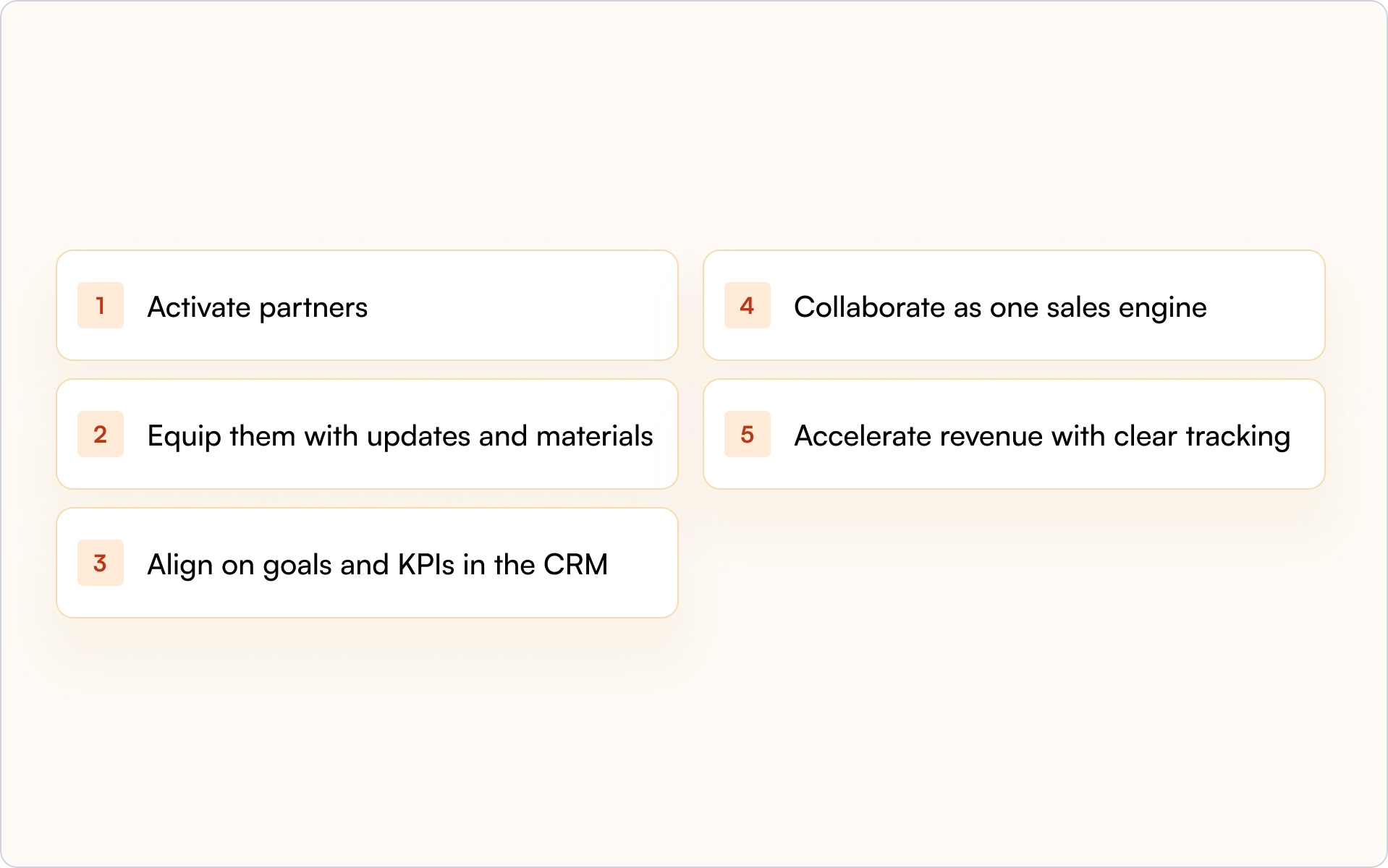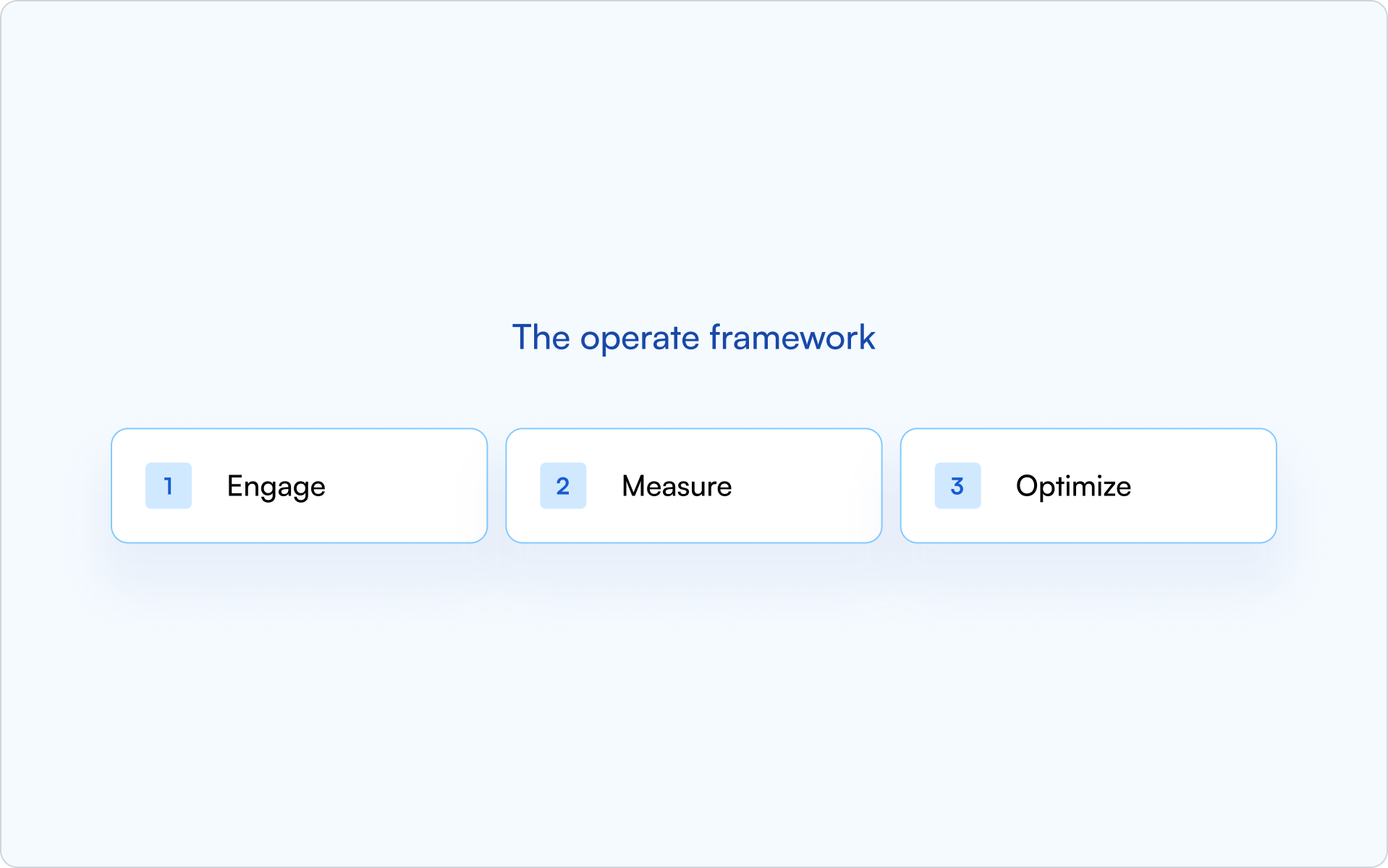In the early days of SaaS channel partnership programs, companies relied heavily on static partner portals and endless email threads.
And although this approach was admittedly clunky and time-consuming, it worked okay while these programs were in their infancy and encompassed only one or two, easily-trackable partners.
But in 2026, the approach to partner programs has shifted dramatically.
Casual, ad hoc partnerships have been replaced by watertight, multi-channel ecosystems inhabited by a wide range of strategic partners.
At the heart of these sophisticated programs? Collaboration, data sharing, co-selling — and a tech stack that can keep up.
After all, manual tasks, disconnected tools, and outdated portals create friction in the partner journey, while platforms with limited automation capabilities put you at an automatic disadvantage.
So what should you be looking for in a modern SaaS partner program tool?
Automation, real-time visibility, and CRM-first platforms that seamlessly integrate into daily workflows.
Several key trends are reshaping the channel landscape:
- AI-powered partner discovery and enablement are accelerating matchmaking and performance tracking.
- Remote selling is making virtual collaboration tools essential.
- Self-service onboarding and content access are empowering partners to move at their own pace.
- “Always-on” enablement means support, training, and updates need to be embedded throughout the partner journey — not just during onboarding.
The future of channel partnership programs is not only more connected — it’s also more impactful, scalable, and aligned with how SaaS businesses grow today.
What Is a Channel Partnership?
Let’s start with an up-to-date channel partner definition.
In SaaS, a channel partnership is a strategic collaboration in which third-party organizations help market, sell, support, or integrate your product, thereby extending your reach beyond direct sales.
Unlike direct sales teams, which engage customers directly, channel partners act as multipliers, introducing your solution to new audiences, markets, or industries.
So, what is a channel partner?
There are many different types of channel partners, including:
- Resellers who purchase and sell your software under their own margins
- Referral partners who pass along leads in exchange for commission
- Managed Service Providers (MSPs) who include your SaaS in bundled services
- Agencies and consultants that implement or recommend your platform
- Tech integrations and ISVs that enhance your product’s capabilities
- OEM partners who embed your software into their offering
- Strategic alliances that co-market or co-sell complementary solutions
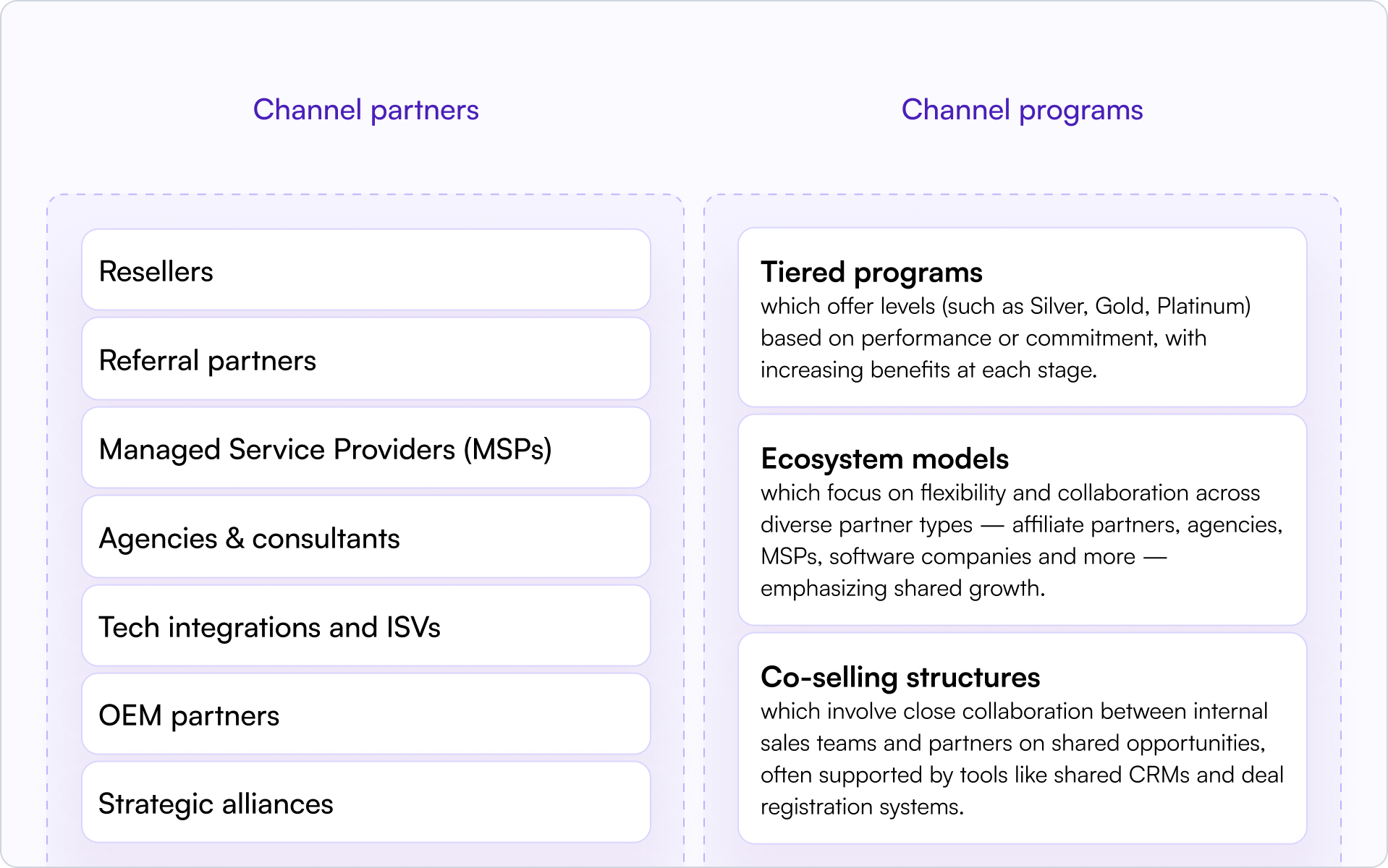
Channel partnership programs vary significantly, depending on the SaaS company’s size, product, needs, and goals.
Some of the most common structures are:
- Tiered programs, which offer levels (such as Silver, Gold, Platinum) based on performance or commitment, with increasing benefits at each stage.
- Ecosystem models, which focus on flexibility and collaboration across diverse partner types — affiliate partners, agencies, MSPs, software companies and more — emphasizing shared growth.
- Co-selling structures, which involve close collaboration between internal sales teams and partners on shared opportunities, often supported by tools like shared CRMs and deal registration systems.
In 2026, SaaS channel programs are increasingly built around flexible, ecosystem-driven structures rather than rigid, tier-based structures.
However, many programs blend the above approaches to support partner autonomy while driving alignment, scalability, and faster routes to market across different partner motions.
Why Channel Partnerships Are More Strategic Than Ever
Channel partnerships are now a core growth strategy for SaaS companies' business models — not just a sales supplement.
When approached strategically, they offer high-margin revenue, specialized expertise, expanded market reach into new market segments, and enable scalable growth without expanding headcount.
Partnerships also help mitigate risk by diversifying go-to-market motions.
The SaaS partner power law is relevant here: typically, 20% of partners drive 80% of the value, making a strategic focus essential.
From a CRO or RevOps perspective, strong channel programs support clearer attribution, more accurate forecasting, and greater operational efficiency.
But without a strategic approach, companies face channel conflict, missed pipeline opportunities, and partner churn — ultimately weakening revenue performance and market competitiveness.
12 Advanced Steps to Win at Channel Partnering in 2026
Ready to reap the benefits of an impactful channel partnership strategy?
Follow these 12 steps to take your SaaS partnerships to the next level.

Step 1: Revisit Your Channel Partner ICP Every Year
To build a high-performing channel, it’s crucial to regularly revisit your Ideal Channel Partner (ICP).
After all, the SaaS industry evolves at lightning speed, so your ICP this year could look very different from the last.
Start your review by analyzing which partners are actively contributing pipeline and revenue.
Note which verticals these top-performing partners operate in and consider their technology stacks, sales motions, and customer types.
Then, use CRM data, engagement tracking, and partner feedback to refine your ICP criteria.
This ensures you focus on partners who align with your product, go-to-market strategy, and growth stage.
Step 2: Build Dynamic, Role-Based Partner Segmentation
Developing effective customer segments allows you to deliver the right experience to the right partners at scale.
Segment by:
- Tier
- Partner type (for example, reseller, ISV, agency)
- Geography
- Engagement/activity level
- Strategic value
It’s also helpful to include roles within your partner companies — for example, sales, marketing, technical — so you can tailor communications and incentives to individual contributors.
This approach enables targeted enablement, personalized support, and performance-based rewards.
For example, high-engagement referral partners might receive co-marketing funds, while new ISVs get onboarding support.
Categorising customers into market segments doesn’t have to be complicated: you can structure it using a simple table like the example below.
Step 3: Invest in Proactive, Personalized Onboarding
In 2026, personalization is no longer merely a nice-to-have; it’s a must.
And it’s super important during the onboarding process, which is most likely your partner’s first real contact with your SaaS brand.
Indeed, a strong, personalized onboarding experience sets the tone for a productive and long-term partnership.
Tailor onboarding experiences based on partner type, tier, and role.
For example, a reseller might need sales training and pricing tools, while a technology partnership benefits more from API documentation and integration support.
Blend live interactions (such as kickoff calls, QBRs, and workshops) with self-serve resources, including videos, guides, and a searchable knowledge base.
Here’s a handy channel partnership best practice for proactive, personalized onboarding.
Auto-trigger onboarding flows when a partner registers a deal or completes signup — ensuring immediate engagement and faster time-to-value.
Step 4: Automate All Critical Partner Communications
Timely, relevant communication is key to keeping partners engaged — but manual outreach doesn’t scale.
Thanks to the rise of automation, in 2026, a small workforce is no longer a barrier to scaling.
Simply automate critical partner updates like:
- Deal status
- Spiff launches
- Deadlines
- Training rollouts
To achieve this, you can use triggers tied to specific partner actions or milestones.
Automating these updates ensures that none of your partners miss essential info while also freeing up your team’s time to focus on more valuable tasks.
It’s important to use a multi-channel approach — for instance, using Slack, email, in-app messages, and CRM alerts — alongside your PRM to meet partners where they already work.
With modern PRMs such as Introw, channel managers can send branded updates directly from their CRM without switching platforms or logging into a portal.
Step 5: Make Engagement Data Visible Across the Business
Transparency is pivotal to channel success.
Sharing partner engagement data (such as email opens, content downloads, meeting attendance, and portal activity) helps align sales, RevOps, and leadership around which partners are driving momentum.
Live dashboards are a game-changer when it comes to transparency and visibility.
Use them to clearly visualize partner engagement data, supporting QBRs, pipeline reviews, and forecasting.
With Introw, partner engagement data flows directly into Salesforce or HubSpot, so teams don’t need to leave their CRM to see which partners are active, which need attention, and where opportunities are growing.
Step 6: Empower Partners With Self-Service Tools
Self-service doesn’t just save time — it builds trust and drives faster, more scalable channel growth.
Empower your partners with self-service tools that make it easy to register deals, access channel partner sales content, complete training, and launch campaigns without login barriers or confusing portals, thereby eliminating friction.
Take it a step further by supporting custom assets and co-branded marketing, allowing partners to tailor their messaging to their target audience.
For example, with Introw, partners can submit co-marketing requests through branded, embedded forms, which automatically trigger internal workflows and approvals.
Step 7: Run Automated, Recurring Campaigns and Nurtures
When it comes to keeping partners engaged, consistency is key.
And, thanks to automation tools, it’s never been easier to stay consistent.
Set up automated, recurring campaigns that deliver timely content, training, and pipeline nudges to ensure consistent engagement.
This might look like:
- Monthly enablement newsletters
- QBR reminders
- Seasonal promotions
- Product update highlights
- Pipeline review reminders
Segment your content and tone of voice based on partner maturity.
For example, new partners may need onboarding touchpoints, while established ones benefit from co-selling tips or market-specific playbooks.
You can also use pre-built templates to re-engage top or at-risk partners with personalized outreach that reignites interest and activity.
Step 8: Master Attribution - Track Every Touch
We’ve always known the importance of accurate attribution in proving the value of a channel partnership program.
Yet historically, getting attribution right has been a time-consuming headache.
But, once you move beyond spreadsheets, accurate attribution is within reach.
Auto-sync all partner activities — for instance, deal registrations, campaign clicks, and content downloads — directly into your CRM.
This allows you to tie revenue back to specific partners, motions, marketing materials, and assets with complete visibility.
By automating attrition, you’ll gain invaluable (and accurate) answers to crucial questions, including:
- Which partners are influencing pipeline
- What content drives conversions
- Where to invest next
In addition to making attrition easier and more accurate, automation tools also enhance visibility, making data-driven decision-making easier across your business.
For example, a CRO could view a real-time forecast of partner-sourced deals within Salesforce or HubSpot, enabling them to report on performance, plan resources, and align teams.
In this way, clean, automated attribution turns insight into strategy.
Step 9: Regularly Review & Upgrade Incentive Structures
Your incentive program should evolve as your partner ecosystem grows.
Attaching incentives to the volume or value of partner bookings is obvious.
But to level up your incentive structure, move beyond one-dimensional rewards tied only to bookings and start rewarding engagement too.
For instance, you could offer bonuses for:
- Training completion
- Content usage
- Co-selling participation
- Marketing activity
Rewarding engagement encourages consistent, long-term behavior rather than chasing one-off wins.
It’s also important to regularly test and iterate incentives to determine what motivates different types of channel partnerships — MSPs, for example, may be motivated by very different rewards than ISVs — and adjust accordingly.
Bring your tier system into 2026 with dynamic tiering.
Within a dynamic tiering structure, quarterly reviews promote or demote partners based on performance and activity, not just deal volume, helping to ensure consistent engagement.
Step 10: Make QBRs (Quarterly Business Reviews) Data-Driven
It’s time to ditch QBR PowerPoints in favor of live dashboards, engagement metrics, and pipeline data.
This creates a more transparent, actionable conversation focused on what’s working, what’s blocked, and how to win together.
Start with a clear, mutual action plan that aligns goals across teams, then dive into valuable insights, such as deal velocity, content engagement, and training progress.
It’s also worth tailoring your prep by role.
For example, CROs should receive high-level growth strategies and revenue forecasts, while partner managers are more likely to want detailed activity breakdowns and enablement metrics.
Step 11: Predict, Not Just React - Use Analytics for Next Steps
The best partner programs don’t just measure — they anticipate.
Leverage engagement trends, pipeline activity, and content usage to identify at-risk partners early and spot emerging top performers.
With analytics and AI, channel managers can receive “next best action” recommendations, which suggest where they should focus their time for maximum impact — whether it’s reactivating a dormant partner or accelerating a high-potential one.
For example, Introw’s live dashboards automatically flag dormant partners showing signs of churn — such as declining logins or no recent deal activity — so you can step in before it’s too late.
Step 12: Create a Feedback Loop to Continuously Improve
Every strong channel partner program is built on two-way communication.
The key to success here is to make it as easy as possible for partners to share their input on their needs and challenges as well as feedback on enablement, product, support, and marketing efforts.
Establish regular feedback channels such as:
- Monthly surveys
- Partner advisory boards
- Open office hours
Most importantly, you must act on the feedback by incorporating it into program updates, campaign planning, and even roadmaps for products or services.
This shows partners that their voices matter.
5 Common Pitfalls & Outdated Practices to Avoid in 2026
So, we’ve discussed how to boost your channel partnership program in 2026, but what shouldn’t you be doing?
Here are five major pitfalls to avoid:

- Relying on static portals and spreadsheets — Manual tools are slow, siloed, and prone to error. They create friction for partners and limit your ability to scale or track real-time performance.
- Overcomplicating onboarding or incentive structures — If partners can’t quickly understand how to get started or what’s in it for them, they disengage with sales efforts.
- Ignoring low engagement signals until too late — A drop in logins or deal registrations often signals a deeper issue. Without proactive monitoring, you risk silent churn and lost revenue.
- One-size-fits-all comms — Generic emails or mass updates miss the mark and will cause partners to tune out.
- Failing to connect partner activity to revenue — Without clear attribution, it’s hard to prove value or optimize performance. Revenue-connected metrics help secure internal support and guide smarter investments.
Channel Tech Stack — Tools That Separate Winners From Laggards
In 2026, your channel tech stack is a key differentiator.
Leading SaaS companies are moving beyond legacy PRMs and static partner portals, adopting CRM-first, frictionless platforms that drive real engagement and measurable results.
Traditional PRMs often require logins, manual updates, and siloed data — making it hard for partners to stay active and for teams to track success.
So what’s new in the world of PRMs?
In 2026, you should be looking for a platform that offers off-portal updates, self-service enablement, automated campaigns, real-time attribution dashboards, and AI-powered nudges that guide partner and channel manager actions alike.
Furthermore, these systems should integrate directly into your CRM (like Salesforce or HubSpot), enabling seamless workflows, deal tracking, and self-service enablement without leaving familiar tools.
Modern PRM Checklist:
✅ CRM-first PRM (Salesforce/HubSpot native)
✅ No-login deal reg, content access, and tools to support co-marketing activities
✅ Automated partner campaigns
✅ Live dashboards for attribution and engagement
✅ AI insights: next-best-action, churn risk, high-potential partners
Upgrading your tech isn’t just about convenience — it’s about enabling scale, accountability, and partner success in a fast-changing SaaS landscape.
Why Introw?
So when choosing a modern PRM, why should you opt for Introw?
Built directly into your CRM (like Salesforce or HubSpot), Introw keeps your CRM as the single source of truth while automating multi-channel engagement, including emails, Slack alerts, updates, and more.
What’s more, it delivers an off-portal experience for partners, helping to eliminate friction and enable mutual growth.
Indeed, partners can submit leads, collaborate on deals, and receive updates through email or Slack, with everything synced back to your CRM.
And thanks to real-time engagement tracking for every role, managers, RevOps teams, and CROs gain instant visibility into metrics like partner-sourced leads, deal progression, support tickets, and engagement across the partner ecosystem.
👉Want to see Introw in action? Request a demo here.
Conclusion - The New Playbook for Channel Partnering
Winning SaaS teams in 2026 are embracing a new standard:
- Automating partner workflows
- Personalizing every interaction
- Measuring impact across the funnel
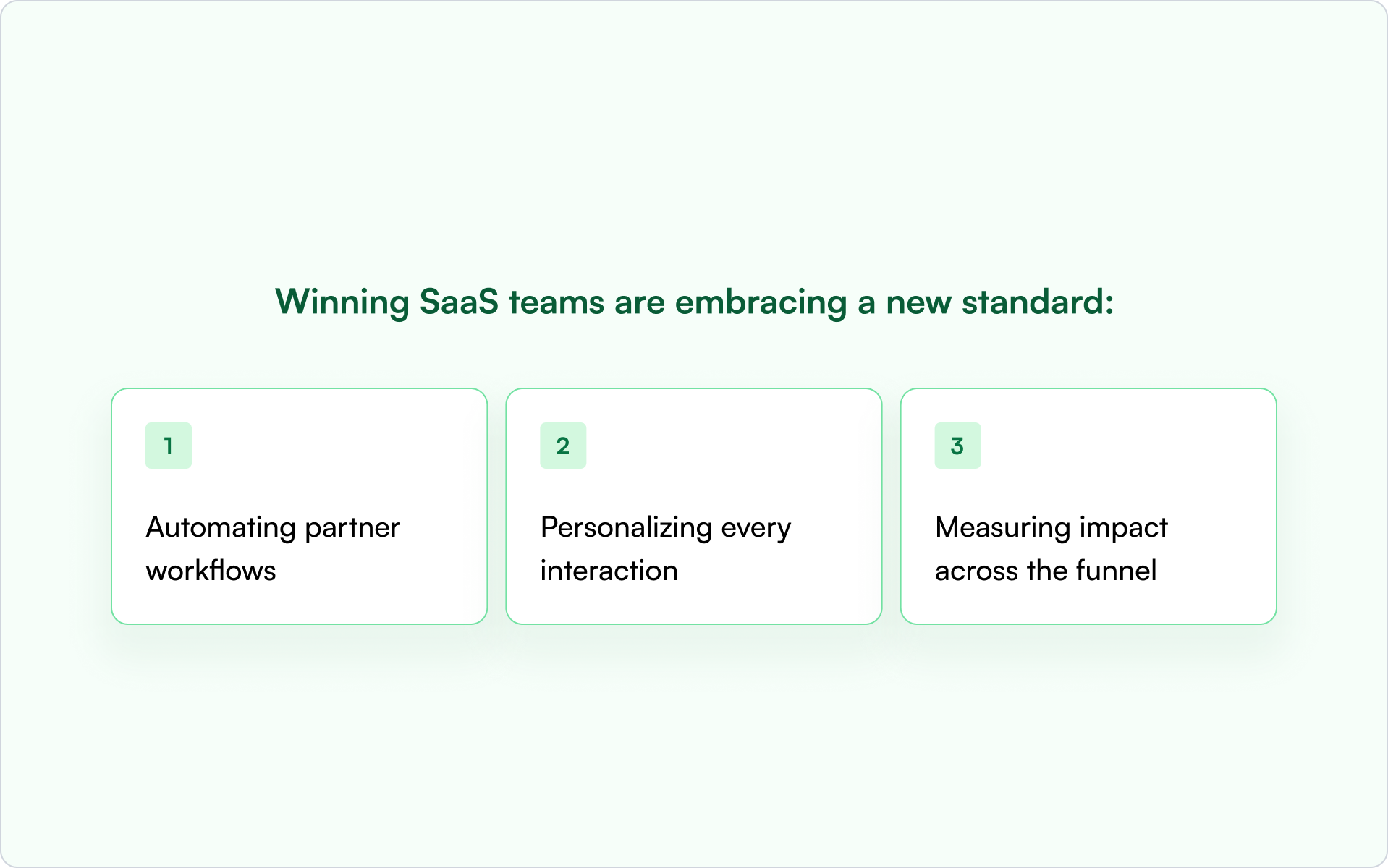
Channel partnership programs are no longer merely a sales lever — they’re becoming a core strategic revenue stream that drives scalable, efficient growth.
To stay competitive, now is the time to audit your current partner motion, identify gaps, and explore how Introw can help you build and power a next-generation, CRM-first channel program. ➡️ Request a demo here today.
What Are The Top Trends In Channel Partnerships For SaaS In 2026?
SaaS partnership programs are becoming ever-more competitive, so it’s vital to stay on top of the latest trends. In 2026, the big trend is ecosystem-led growth, in which SaaS brands are driving mutual growth and revenue via a network of interconnected partners (think tech partners, channel partners and integrations). On the tech front, we’re seeing more AI-driven partner enablement, onboarding and collaboration, as well as deeper integrations with platform marketplaces. Data usage continues to evolve too, with more comprehensive partner success metrics and increased data-sharing transparency.
How Do I Know If My Current Portal Or PRM Is Holding Me Back?
If your portal or PRM is not deeply integrated with your CRM, takes months to implement, or fails to support off-platform communication, it’s likely slowing your growth. The biggest sign that your PRM or portal is holding you back from business growth is low partner engagement. Indeed, if your strategic partners are struggling to navigate or self-serve, it’s time to reassess the effectiveness of your system.
What Metrics Should I Use To Measure Channel Partner Success in 2026?
Key metrics for channel partner relationships success include: - Partner-sourced revenue - Deal registration volume - Win rate - Pipeline contribution - Partner engagement levels In order to measure successful channel partnerships, it’s also helpful to track training completion, portal logins, the success of sales strategies, and marketing initiatives. Measuring both performance and participation gives a full view of partner impact and growth potential.
Can I Automate Engagement Without Adding Friction?
The short answer is yes — it just takes a bit of thought. Automate PRM engagement without adding friction by using personalized workflows, timely notifications, and AI-driven content recommendations. Focus on simplifying partner management processes such as deal registration, training, and onboarding. Automating these tasks will enable them to occur more quickly and without human error, benefiting both partners and yourself, and facilitating a mutually beneficial relationship where new customers are brought in faster. Remember, the key is to enhance partner experience — automation should support, not replace, meaningful human interaction.


.svg)



















